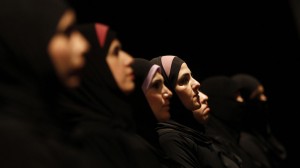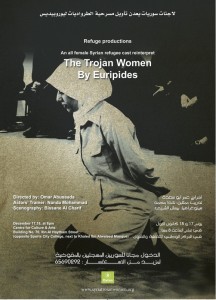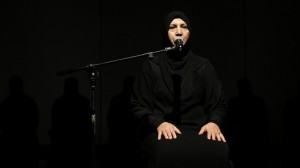On the 18th of December, the Syrian Trojan Women project staged a production of Euripides’ tragedy The Trojan Women with a cast of Syrian refugee actors and crew in Amman. Their reinterpretation of this 2000-year-old play traces the parallels between the fates of the women of Troy and contemporary Syrian women refugees fleeing the violence in their country.

“Euripides’ The Trojan Women is set at the fall of Troy. It is about the fate of the defeated and exiled. Weapons may change but war is eternal and there are enormous parallels between the fate of refugees from Syria today and that of the women of Troy. The women of Syria have seen their homes destroyed and their families wounded and killed, raped and brutalized, and have been forced to flee into exile.”
The website lists the aims behind the project, including raising awareness of the refugee crisis, providing employment and alleviating depression and boredom through holding drama groups and workshops. This poster states that entrance is free for Syrians registered with the UNHCR.
One of the women taking part in the project, Fatima (second name is not provided), described the sense of empowerment and focus she felt the workshops gave her, as well as her identification with the character of Hecuba, who she sees as having, like herself, lost everything, including her country:

“They can identify, of course, because the Trojan women is a play about refugees. It’s set just after the fall of Troy; the men of Troy are all dead, and the women, refugees, await their fate by tents of their new Greek overlords. Euripides wrote the play in 415 BC as a protest, after the Athenians’ took the island of Melos, killed all the men and sold the women into slavery.”
In the same article, though, Eagar also mentions that the choice of the play was questioned by some people who felt less identification with this classic play:
“The electrical engineer said aggressively, ‘But of course the case of Assad is entirely different to that of Troy! Why don’t you write a play about Syria?” I said I haven’t got time. And Euripides’ Trojan Women is a very famous play and people – with any luck – will give us money to put it on.”
The reasons for the choice of the play are represented here as lack of time to write original content, the familiarity of Euripides’ play, and the fact that people will give money to the project. Of course, money is central, since the project is described as “funded entirely by charitable donations” and in her article, Eager begins by describing herself standing in the Frontline Club behind the podium, “staring at the row of faces I was asking for money” with a projector running “a constant loop of harrowing images from the Syrian war.” The video of this event is available here:
Eren wrote a post last week about the inevitable power dynamics of fundraising. This is clearly a much more nuanced and collaborative project than the event Eren describes: there are Syrians involved in the project and in the fundraising; there is a sense of the history of this country and the politics behind the conflict; and the focus on the humanitarian efforts are placed in context. The project presents itself as one possible way to help alleviate the suffering of Syrian refugees until the resolution of the conflict, which the organizers see as coming through diplomatic negotiations, as in Bosnia.
Nevertheless, some of Eren’s points come through here. Those silent images projected on the screen behind the speaker are slightly jarring, given the aims of this project, which include giving the refugees a voice and a chance for them to tell their own stories. For example, the video of Fatima speaking about her identification with Hecuba would have made more sense than an image of an unnamed Syrian woman pointed out as the perfect Hecuba. There is an element of tragic inevitability in the description of “a man in long traditional robes with a face like Agammenon.” The most jarring part of this presentation, however, were these sentences:
“One might think that people in this situation would not necessarily be receptive to the idea of performing a 2,400 year old play. But when Oxfam’s Jordan-partner Voice, first introduced me to a group of black head-scarved, black robed women, the women’s faces lit up.”
Perhaps it’s just me, but at this point I was wondering why exactly this description of their clothing was relevant – also, although the women aren’t dressed all in black in the workshop images, they are all in black in the play.















